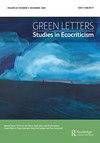社论:关于可爱、震惊、浪漫和庇护
Q1 Arts and Humanities
引用次数: 0
摘要
从可爱的政治和避难所的雨水条件到震撼和浪漫的生态力量,《绿色信件》的开放版收录的七篇文章结合了广泛的方法和材料,在生态批评学术中开辟了新的、有时出乎意料的基础。虽然本期的几篇文章在对树木景观、生物符号学和诗歌与科学之间的历史关系的研究中,强烈地建立在生态批评思想的既定分支上,但其他文章要求我们走出常规的道路,并与明显非常规和未被充分研究的生态思想库保持一致。除了熟悉的树木、风暴和城市景观等生态问题外,我们还被邀请思考沉默的凯蒂猫(Hello Kitty)形象,并考虑米尔斯和布恩(Mills & Boon)流行的浪漫幻想的生态批评潜力。虽然这些材料最初可能不会给我们带来通常的环境思想素材,但《绿信》一直是一个寻求在该领域培养新方向的空间,在这一期中,我们继续致力于支持创新研究,这些研究将使我们摆脱学科的自满,动摇根深蒂固的知识等级。这期的开头,Keith Moser的文章《J.M.G. Le clacimzio小说的生物符号学解读:(重新)设想超越人类的符号学和跨特定交流的复杂性》提供了对这位诺贝尔奖得主小说作品中非人类旋律的丰富解读。Le clacimzio的作品因其与非人类世界的感性接触而引起了学者们的注意,而Moser的分析则将我们更深入地带入“一个由重叠的符号学领域组成的世界”,跟随生物符号学关系的线索,因为它们编织在一个扩大的生命之网中。与“人类符号学代理对抗没有灵魂的自动机”的二分和等级思维模式相反,莫泽认为,Le clacimzio的作品邀请我们进入“我们沉浸其中的符号学元素交响曲的辉煌”。莫泽对西方人文主义传统提出的只有人类才能“参与有意义的符合学”提出质疑,他的解读触及了一系列令人眼花缭乱的“主动诠解者”,包括鸟类、树木和细菌,并引出了它们伴随的感官和化学交流模式,以挑战将人类定位为最高传播者的物种主义观点。莫泽的观点反对将非人类生命解读为语言贫乏,他邀请我们进入跨物种的交流和意义构建形式,并考虑文学在将我们与非人类世界的铿锵复调联系起来方面所扮演的角色。下一篇文章将把我们从非人类交流的等级制度带入动物研究中的可爱政治。在她的文章《只是一只愚蠢的兔子:被驯化的雌性动物的传统与反叛》中,伊莎贝尔·加勒莫尔提供了Hello Kitty的标志性拟人化形象,并提出了一个简单而又具有挑衅性的问题:“为什么Hello Kitty没有嘴巴?”建立在前面对生物符号学的考虑之上,绿色信件:生态批评研究2022,VOL. 26, NO。4,303 - 306 https://doi.org/10.1080/14688417.2022.2229035本文章由计算机程序翻译,如有差异,请以英文原文为准。
Editorial: On Cuteness, Shock, Romance, and Refuge
From the politics of cuteness and the pluvial conditions of refuge to the ecological potency of shock and Romance, the seven essays gathered in this open edition of Green Letters incorporate a wide spectrum of methodologies and materials that strike new and at times unexpected grounds in ecocritical scholarship. While several essays in this issue build strongly upon established tranches of ecocritical thought in their examination of arboreal landscapes, biosemiotics, and historical relations between poetry and science, other articles ask us to step off the beaten track and to attune to distinctly unconventional and understudied repositories of ecological thought. Alongside the familiar ecological matter of trees, storms and cityscapes, we are invited to contemplate the mute figure of Hello Kitty and to consider the ecocritical potential of the popular Romance imaginaries of Mills & Boon. While these materials might not initially strike us as the usual fodder of environmental thought Green Letters has always been a space that seeks to foster new directions in the field, and in this issue we continue our commitment to support innovative research that shocks us out of disciplinary complacency and destabilises entrenched knowledge hierarchies. Opening this issue, Keith Moser’s article ‘A Biosemiotic Reading of J.M.G. Le Clézio’s Fiction: (Re-) Envisioning the Complexity of Other-Than-Human Semiosis and TransSpecific Communication’ provides a rich reading of the score of nonhuman melodies that mark the Nobel Laureate’s novelistic oeuvre. Where Le Clézio’s work has drawn attention from scholars for its sensuous engagement with the nonhuman world, Moser’s analysis takes us deeper into ‘a world comprised of overlapping semiotic realms’, following the threads of biosemiotic relation as they weave through an expanded web of life. Against dichotomous and hierarchical modes of thought that pit ‘the human semiotic agent against soulless automata’, Moser argues that Le Clézio’s work invites us to tune into the ‘splendor of the semiotic elemental symphony in which we are immersed’. Interrogating Western Humanist traditions that suggest only humans can ‘engage in meaningful semiosis’, Moser’s readings alight upon a dazzling range of ‘active interpreters’, including birds, trees, and bacteria, and draws out their attendant modes of sensorial and chemical communication to contest speciesist perspectives that position the human as the apex communicator. Against readings of nonhuman lives as linguistically impoverished, Moser’s argument invites us to tune into trans-species forms of communication and sense-making, and to consider the role literature plays in connecting us to the sonorous polyphony of the non-human world. The next article takes us from the hierarchies of non-human communication into the politics of cuteness in animal studies. In her piece, ‘Just a Dumb Bunny: The Conventions and Rebellions of the Cutified Feminised Animal’, Isabel Galleymore offers up the iconic anthropomorphic image of Hello Kitty and asks one simple, provocative question: ‘why does hello Kitty lack a mouth?’ Building on the preceding consideration of biosemiotics, GREEN LETTERS: STUDIES IN ECOCRITICISM 2022, VOL. 26, NO. 4, 303–306 https://doi.org/10.1080/14688417.2022.2229035
求助全文
通过发布文献求助,成功后即可免费获取论文全文。
去求助
来源期刊

Green Letters
Arts and Humanities-Literature and Literary Theory
CiteScore
0.50
自引率
0.00%
发文量
38
期刊介绍:
Green Letters: Studies in Ecocriticism explores the relationship between literary, artistic and popular culture and the various conceptions of the environment articulated by scientific ecology, philosophy, sociology and literary and cultural theory. We publish academic articles that seek to illuminate divergences and convergences among representations and rhetorics of nature – understood as potentially including wild, rural, urban and virtual spaces – within the context of global environmental crisis.
 求助内容:
求助内容: 应助结果提醒方式:
应助结果提醒方式:


